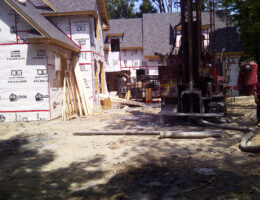Strainer type well
What is a strainer type well?
The depth of an artesian well can vary greatly, so it is impossible to know the depth before digging. For the purposes of well drilling, the ground can be divided into two categories: the overburden* (sand and gravel) and the bedrock. We can find water in both land types.
If there is a sufficient quantity of water in the overburden (sand and gravel), it won’t be necessary to dig down to the bedrock.
Strainer type wells allow groundwater to be absorbed in the sand and gravel deposits. This technique is used when we obtain a sufficient volume of water without digging down to the bedrock. In this case, it is possible to harvest water with a strainer placed in the sand and gravel formation.
What does the strainer do?
The strainer is a stainless steel filter tube inserted into the well at the lower end of the borehole, with openings chosen according to the sand and gravel grain size (the size of the grains), and is required to prevent the entry of particles in the water during pumping. This device lets the water filter through, but not the sand or gravel.
Do we find a lot of water in sand and gravel?
Sand and gravel are not certain to contain water, but they frequently do. They have great porosity and good permeability, making them good aquifers** because the water accumulates there easily.
To find out more about artesian wells, don’t hesitate to contact our team; we will be happy to answer any of your questions.

* The overburden is all the sediment that covers the rock base.
** An aquifer is a geological formation or a rock which is sufficiently porous and/or cracked (to store large quantities of water) and sufficiently permeable to allow water to circulate freely.
Sources : https://fr.wikipedia.org/wiki/Aquif%C3%A8re
https://rqes.ca/les-depots-meubles/




